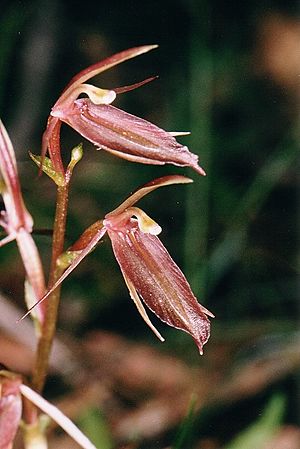Large gnat-orchid facts for kids
Quick facts for kids Large gnat orchid |
|
|---|---|
 |
|
| Cyrtostylis robusta in the Serendip Sanctuary | |
| Scientific classification | |
| Genus: |
Cyrtostylis
|
| Species: |
robusta
|
The Cyrtostylis robusta, also known as the large gnat-orchid or mosquito orchid, is a special type of orchid. It grows only in southern Australia. This plant usually has one round-ish leaf. Its flowering stem can have up to seven reddish flowers. Each flower has a unique, shelf-like part called a labellum.
What Does It Look Like?
The large gnat orchid is a plant that grows from the ground. It is a perennial plant, meaning it lives for more than two years. It's also deciduous, so its leaves fall off at certain times. This plant has a single leaf that can be shaped like a heart, a kidney, or almost perfectly round. This leaf is about 1.6 to 6 centimeters (0.6 to 2.4 inches) long and 2 to 4 centimeters (0.8 to 1.6 inches) wide. The top of the leaf is light to medium green, and the bottom is shiny and silver.
The orchid's flowers grow on a stem that can be 4 to 30 centimeters (1.6 to 12 inches) tall. There are usually two to seven pinkish-red flowers on each stem. Each flower is about 1 to 2 centimeters (0.4 to 0.8 inches) long and about 0.6 centimeters (0.2 inches) wide.
The different parts of the flower include:
- The dorsal sepal (the top part) stands upright and curves forward. It's about 1 to 1.3 centimeters (0.4 to 0.5 inches) long.
- The lateral sepals (side parts) are about 1 to 1.1 centimeters (0.4 inches) long. They curve forward or downward.
- The petals are similar to the side sepals and also curve forward or slightly down.
- The labellum is the special lip-like part of the orchid. It's oblong (longer than wide) and about 1 to 1.5 centimeters (0.4 to 0.6 inches) long and 0.4 to 0.6 centimeters (0.16 to 0.24 inches) wide. It slopes slightly downward and has a few small teeth near its pointed tip.
These orchids usually bloom from May to October.
This orchid looks a bit like C. huegelii, which grows in Western Australia. However, the large gnat orchid usually has fewer, brighter flowers and a wider labellum. In South Australia, it can be told apart from C. reniformis because C. reniformis has leaves with more visible veins and are green on the underside, not silvery.
How It Was Named
The large gnat orchid, Cyrtostylis robusta, was officially described for the first time in 1987. Two botanists, David Jones and Mark Clements, gave it its scientific name. They published their description in a science journal called Lindleyana. The plant they studied was found near Jerramungup.
The second part of its scientific name, robusta, comes from a Latin word. It means "oaken" or "strong like oak." This name likely refers to the plant's sturdy appearance.
Where It Lives
The large gnat orchid grows in southern Victoria. Here, you can find it in coastal scrub areas and forests. It also lives in the southeastern part of South Australia, including Kangaroo Island, and in Tasmania.
It is most common and widespread in the south-west of Western Australia. In this region, it grows in shrubland, woodland, and forest areas close to the coast. You can find it between the cities of Perth and Israelite Bay.
Conservation Status
The large gnat orchid, Cyrtostylis robusta, is considered "rare" in Tasmania. This means there are not many of these plants left in Tasmania. It is protected under a law called the Threatened Species Protection Act 1995. This law helps to protect plants and animals that are at risk of disappearing.

